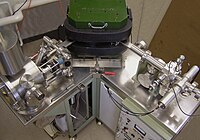
Photo from wikipedia
Australian savannas lack native megaherbivores (>500 kg body mass), but since the commencement of European colonisation in the 19th century bovine livestock, such as cattle (Bos sp.) and water buffalo (Bubalus… Click to show full abstract
Australian savannas lack native megaherbivores (>500 kg body mass), but since the commencement of European colonisation in the 19th century bovine livestock, such as cattle (Bos sp.) and water buffalo (Bubalus bubalis), have established large feral populations that continue to geographically expand. The largest extant native herbivores are marsupials in the family Macropodidae (henceforth 'macropods': common wallaroo, Osphranter robustus [c. 40 kg]; antilopine wallaroo, O. antilopinus [c. 35 kg] and agile wallaby, Notamacropus agilis [c. 20 kg]). These species occur at low densities, with evidence that some species are in decline, the cause of which remains uncertain. We tested the hypothesis that bovines and macropods compete for nutritious forage in the North Kimberley, Western Australia by using carbon isotope analysis of feral cattle and native macropod dung (as a proxy for the relative contribution of C4 grass to their diet) and nutrient analysis of standing herbaceous biomass. Grass consumption varied between macropod species and was highest in larger wallaroo species and lowest in the smaller agile wallaby reflecting its broader diet. Grass consumption by wallaroos was maximal on fertile sites. The relative abundance of grass in the diet of cattle was lowest in the middle of the dry season with an interaction between fire and substrate fertility where grass consumption was highest on fertile sites, particularly those recently burnt. Grass consumption by cattle and wallaroos was negatively correlated with fibre content of live biomass, which was lowest on fertile and burnt sites. Introduced bovines shift their diets to non‐grasses as quality of herbaceous biomass declines with increasing fibre content, and by contrast, the largest macropod herbivores do not have this dietary flexibility. We conclude a plausible mechanism for the success of bovines and the decline of large macropods in Australian savannas is competition for nutritious grass that is abundant immediately after fire.
Journal Title: Austral Ecology
Year Published: 2019
Link to full text (if available)
Share on Social Media: Sign Up to like & get
recommendations!